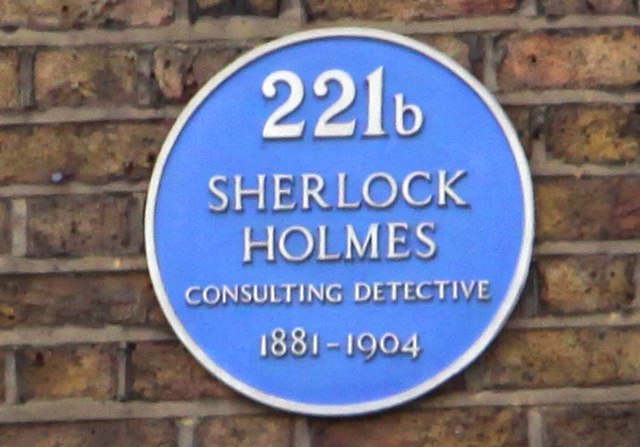
It’s 130 years since Sir Arthur Conan Doyle published his first Sherlock Holmes novel and his character is, after numerous incarnations on screens large and small, probably going stronger now than it has since the early 20th century.
Back in the 1880s, though, Holmes’ creator wasn’t finding life particularly easy. He had moved to London from Edinburgh to set up as an ophthalmologist and things weren’t going quite according to plan.
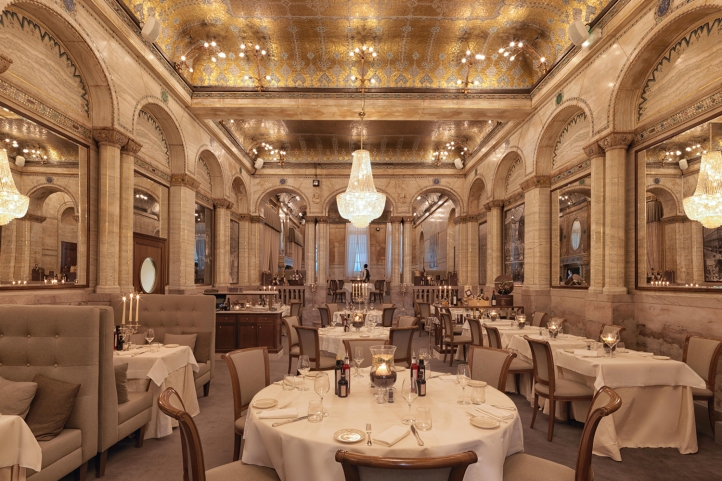
Holmes’ first bow
Stephen Liddell runs Sherlock Holmes tours of London and has researched many places in the capital related to the author and his creations.
He says: ‘Conan Doyle had set up a practice on Montague Street, opposite the British Museum, but he found out after a while that he couldn’t afford the rent. It was here that he started writing his first Sherlock Holmes novel.’
Possibly for that reason, when Doctor Watson makes his very first appearance in the novel A Study in Scarlet, he is contemplating a move to the country because his income as a retired army doctor isn’t keeping pace with the cost of living in London.
Watson wasn’t exactly living like a hermit, however. It is at the bar of the Criterion restaurant in Piccadilly on New Year’s Day in 1881 when he bumps into the old acquaintance who provides the introduction to Holmes.
At the time the Criterion was a pretty desirable venue. Designed in an opulent, oriental-inspired style it had opened in 1873 and had quickly become popular with well-heeled shoppers on trips to the West End.
Still featuring its original gilded ceiling and Byzantine-style arches and tilework, the restaurant has endured ups and downs in recent years. In 2015, for example, it closed its doors when its former owners filed for bankruptcy citing a huge hike in rent (Conan Doyle would no doubt have sympathised with their predicament).
Today it is at least back on an even keel, host to Savini at Criterion – an offering that has received somewhat mixed reviews. Food critic Jay Rayner, writing in The Guardian, lamented its ‘clumsy cooking’ and ‘ludicrous prices’.
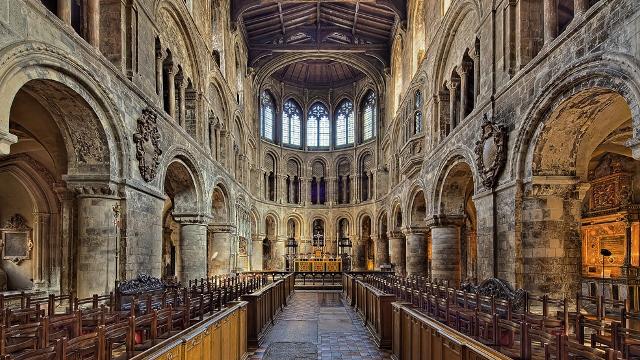
Smithfield and St Barts
From the Criterion, Watson makes his way to St Bartholomew’s hospital, where he was a student and where Holmes is conducting research. Much of the building itself would be recognisable to Conan Doyle; in particular its main gate which incorporates the only statue of King Henry VIII in the capital.
Inside, ‘the long corridor with its vista of whitewashed wall and dun-coloured doors’ that greets Watson’s eyes may not be all that far off the mark either.
The ongoing TV series Sherlock also used the hospital for one of its more dramatic scenes. It is from its roof that Benedict Cumberbatch’s character supposedly jumps to his death.
Across the road, the 12th-century St Bartholomew the Great church can also lay claim to a Holmes connection.
In the 2009 film Sherlock Holmes, with Robert Downey Jnr in the title role, its crypt doubles as that of St Paul’s Cathedral.

Holmes’ favourite restaurants
The film also features the Reform Club at 104 Pall Mall, whose interior was transformed into the Royale restaurant where Holmes interrupts Watson and his fiancée at dinner.
Founded in 1836 by leading politicians and others who backed the Reform Act – which extended the right to vote – the club is not only one of London’s most exclusive, but is also popular with film-makers because of its imposing late Georgian architecture.
With an interior resembling a grand Italian palace, the club is also the place where French writer Jules Verne places his character Phileas Fogg to begin and end his journey around the world (in 80 days).
That restaurant may have been a film-maker’s creation, but you don’t have to travel far to find another that genuinely was a favourite of Conan Doyle and his fictional detective.
Simpsons-in-the-Strand first opened its doors in 1828 and is referred to several times, once by Watson as ‘our Strand restaurant’.
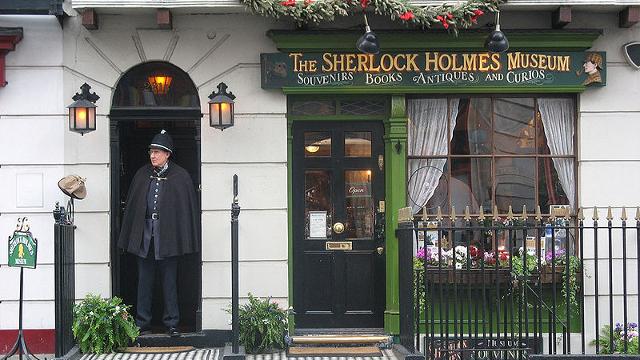
Bluffing in Baker Street
While Conan Doyle enjoyed adding to the realism of his yarns by the mention of real places, his detectives’ lodgings at 221B Baker Street, were entirely fictitious.
Liddell explains: ‘At the time Conan Doyle wrote the Sherlock Holmes books, Baker Street only went up to around number 100. He didn’t want readers to assume Holmes was a real person or for anyone to be bothered by people trying to employ a fictional detective. So he chose an address that was plausible, but false.’
It exists now; although, with a Sherlockian twist, things are not what they appear. At first glance, the site is home to the Sherlock Holmes museum, which has created its own appealing version of the great detective’s home, hidden away behind a front door carrying the number 221B. Added to that there is an official-looking blue plaque that states: ‘Sherlock Holmes. Consulting Detective. 1881-1904’.
It’s all a bluff, however. The plaque is merely an artwork and the building actually occupies numbers 237-241, although the museum does receive all the post that is sent to Holmes – even in this day and age there is plenty.
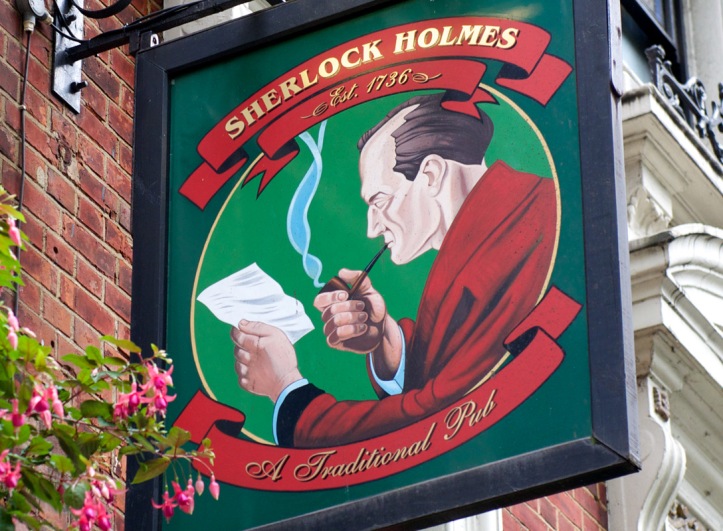
Three more Holmes venues
The Sherlock Holmes pub, Northumberland Avenue. Home to a collection of memorabilia, this Holmes- themed pub is built on the site of the former Northumberland Hotel, where Sir Henry stays in The Hound of the Baskervilles.
The Hunterian museum. In The Hound of the Baskervilles, Dr Mortimer spends a day of ‘pure amusement’ among its eclectic medical displays.
Sherlock Holmes statue. Rather elongated and cadaverous, a three-metre-high statue of Holmes stands outside Baker Street underground station.
Reblogged this on Stephen Liddell and commented:
Recently I was interviewed by a wonderful writer who had noticed the guided tours I run and who shares my interest in Sherlock Holmes and the writer Sir Arthur Conan Doyle. His article is a wonderful mix of classic Sherlock Holmes and the current BBC hit Sherlock. I hope you all enjoy it and check out his wonderful blog. Don’t miss the new Sherlock show on BBC1 on Sunday evening, I can say for a fact that at least one scene takes place right on my usual Sherlock route so I can add that to the tour very easily. Lucky old me! When you see Sherlock reading the note on the bench, that is Byng place in the very heart of Bloomsbury and Sherlock country and just across the road from where the very first Sherlock movie was filmed around 95 years ago!
LikeLike
Reblogged this on MALLA DUNCAN and commented:
For the Sherlock Holmes fans – and anybody wanting to do a walking SH tour of London.
LikeLike